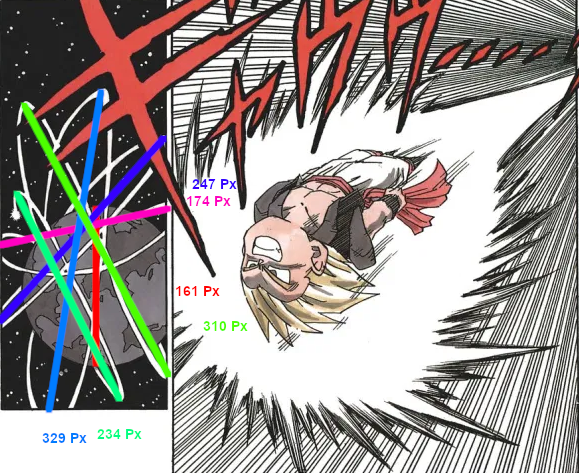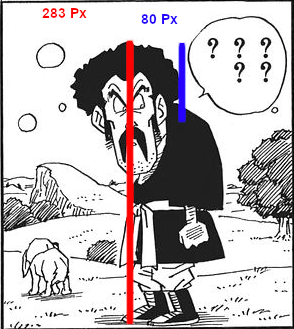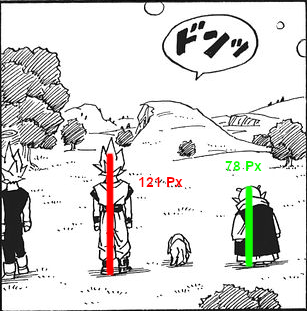Yep, it’s already that time! The Cell and Buu sagas do offer plenty of impressive showings, but most are below planet busting and therefore pointless to calculate. I’m only focusing on the most impressive feats in this post.
Cell’s Solar System Busting Claim

The Android/Cell saga is almost exclusively about threats to destroy things when it comes to feats. Because the powers have gotten so big that blowing up the planet is trivial… but they kinda need the planet to keep the plot going. SSJ Vegeta says he has to hold back so as not to blow up the planet, and Vegeta’s Final Flash was also a threat to Earth until he concentrated it into a thin stream of sorts. King Cold also mentions that he or Freeza could blow up Earth in one shot because it was such a small planet. Cell does blow up King Kai’s planet which has 10 g, but it’s so small that the minimum required energy is only around 40 Megatons, paltry for this point in the series (Although interestingly it does make the planet hundreds of thousands of times more dense than uranium lol)
However, the ultimate claim to power comes here. Cell comes back more powerful than ever, then makes the claim that he’s gathered enough energy to destroy the solar system. As always, I’m not going to comment on the validity or likelihood of such a claim. I’m instead going to calculate the amount of energy he’d need to do such a thing.
The easiest way to destroy a solar system (It’s not actually easy) is to destroy the sun. For that, we can use Gravitational Binding Energy.
The formula for GBE of a planet differs from a star, however. Instead, it’s expressed as:
3 GM^2 / r (5 – n)
G is the gravity constant, .0000000000667384 m^3 kg s
M is the mass of the sun, 1,989,000,000,000,000,000,000,000,000,000 kg
r is the radius of the sun, 696,340,000 m
n is the polytrope of the star. For our sun, n = 3
3 * .0000000000667384 * 1,989,000,000,000,000,000,000,000,000,000^2 / 696,340,000 (5 – 3) = 568,741,963,149,610,822,299,451,417,411,030,000,000,000 J or 135,932,591.575 Yottatons
As for outright destroying the entire solar system, I’m having trouble figuring out what it would take, energy-wise. My first thought was that, as long as the total energy is enough to destroy the sun and any single planet in the system, perhaps Inverse Square law could work?
You know what my favorite part about calculating this is going to be? Pluto’s going to get the credit it deserves! Back in the 90’s when this chapter came out, Pluto was still considered a planet. So I’m going to use its distance from the Earth as the “radius” of the explosion. Suck on that, NASA! 😀
First and foremost, what’s the GBE of Pluto?
U = 3GM^2 / 5R
Gravity constant remains the same, .0000000000667384 m^3 kg s
Mass of Pluto is 13,090,000,000,000,000,000,000 Kg
Radius of Pluto is 1,188.3 km
3 * .0000000000667384 * 13,090,000,000,000,000,000,000^2 / 5 * 1,188,300 = 5,774,045,966,695,278,969,957,081,545.064 J or 1.38 Exatons
Alright, now for the Inverse Square Law. Cell threatens to destroy the solar system from Earth specifically and if he didn’t simply mean destroying the sun, which would also do the job, then we have to assume that the explosion would reach from Earth all the way to Pluto and still destroy it.
Distance between Earth and Pluto is 4.2 – 7.5 billion Km depending on what part of their orbit each respective planet is in. So, I’ll just take the average of that range to make things easy. 5,850,000,000 Km, which will serve as the radius of the explosion.
If we treat the explosion as a sphere, the surface area would be a whopping 430,050,000,000 Km^2 or 430,050,000,000,000,000 m^2
The surface area of Pluto, meanwhile, is 17,700,000 Km^2 or 17,700,000,000,000 m^2
Using the relation between the surface areas, we can also find the relation in energy…
430,050,000,000,000,000 / 17,700,000,000,000 * 5,774,045,966,695,278,969,957,081,545.064 = 140,289,743,953,520,040,736,160,616,861,850 J or 33.53 Zettatons.
This presents a problem in that it wouldn’t even fully destroy Earth, let alone the other planets. I suppose just because Pluto is the farthest away, doesn’t mean it requires a great source energy, as it is tiny.
So how about we try one more thing? If the blast originates on Earth, I’ve proven that the effects can destroy Pluto if it reaches it. Therefore, a blast originating on Earth that destroys the sun should be able to do the same. So I’m going to use the sun instead.
We already found the GBE of the sun to be 568,741,963,149,610,822,299,451,417,411,030,000,000,000 J, so I need distance for the blast radius, and the two surface areas.
The sun is 148,420,000 Km or 148,420,000,000 m from Earth. The sun’s surface area is 6,090,000,000,000 Km^2 or 6,090,000,000,000,000,000 m^2. The surface area of our theoretic explosion would be 277,000,000,000,000,000 Km^2 or 277,000,000,000,000,015,000,000 m^2
Using the same formula as before…
277,000,000,000,000,015,000,000 / 6,090,000,000,000,000,000 * 568,741,963,149,610,822,299,451,417,411,030,000,000,000 = 25,868,887,322,240,098,862,090,221,222,358,000,000,000,000,000 J or 6,182,812,457,514.363 Yottatons.
That’s about 2.5x stronger than the estimated energy of a hypernova, the much more powerful version of a supernova, pretty much! Consider this a higher-end though, as like I said before, simply destroying the sun would do the trick. There is no solar system without the sun.
Gotenks’ Trip Around the World


Gotenks loops around the world 5 times, and even has time to take a nap before Piccolo catches up. According to Piccolo, Gotenks only has 1 minute left in the fusion before he separates, so that would make the elapsed time 29 minutes. However, there’s also the aforementioned “afternoon nap” that Gotenks references. Optimal nap time is 10-20 minutes according to studies. So 10 minute nap would reduce the time frame to 19 minutes, while 20 would make it 9. This would make for a good range, I think, as both are viable and good enough for people to draw their own conclusions.

Gotenks obviously moves around the planet in an oval-like circumference, so aside from what I’ve already measured, my assumption for the diameter (smaller) that I can’t measure will be that it’s equal to the diameter of Earth, which does make this lower end in all likelihood.
Sorry for any confusion by the way, but it’s a small panel so be sure to keep an eye on the color coding. Earth measures at 161 pixels here. It’s 12,742 km in diameter. Going from the top text to bottom: Loop 1 measures 247, loop 2 is at 174, loop 3 is 310, loop 4 is 329, and loop 5 is 234.
247 / 161 = 1.534 * 12,742 = 19,546.228 Km, long axis of loop 1.
174 / 161 = 1.081 * 12,742 = 13,774.102 Km, long axis of loop 2.
310 / 161 = 1.926 * 12,742 = 24,541.092 Km, long axis of loop 3.
329 / 161 = 2.044 * 12,742 = 26,044.648 Km, long axis of loop 4.
234 / 161 = 1.453 * 12,742 = 18,514.126 Km, long axis of loop 5.
Okay, now using the Earth’s diameter as the short axis of the loop, we can get circumference for each.
Loop 1 = 103,664.331 Km
Loop 2 = 83,365.871 Km
Loop 3 = 122,853.848 Km
Loop 4 = 128,819.263 Km
Loop 5 = 99,854.367 Km
Adding these all together, the total distance comes to 538,557.68 Km.
Alright, for the low-end, we have a time frame of 19 minutes. 19 * 60 = 1,140 s.
538,557.68 / 1,140 =472.419 Km/s or Mach 1,389.468
For a time frame of 9 minutes… 9 * 60 = 540 s.
538,557.68 / 540 = 997.329 Km/s or Mach 2,933.321
And just for the hell of it, if we say that Gotenks took a 28 minute nap and flew around the globe in a minute…
538,557.68 / 60 = 8,975.961 Km/s or Mach 26,399.885 (3% light speed)
I guess the real weakness here is that the time frame can be anything within 29 minutes. It could be a second, 28 minutes and 59 seconds, or even a microsecond. We have no idea. That’s why I’m giving a range of what I think is acceptable. The true result could be higher or lower.
Note: I really wanted to figure out something for Buu and Gotenks creating wormholes to other dimensions, but there is nothing scientifically concrete out there yet. It’s all heavily speculative. The idea, though, is that you can pull apart two black holes to make a wormhole… the issue here of course is that there’s no black hole in sight so it may just be chalked up to a magic wormhole…
Kid Buu Blows Up Earth



Kid Buu blows up Earth with a single blast, marking the first time in the manga that someone has done this on-panel, believe it or not. What’s nice though is that for once we don’t have to rely on gravitational binding energy. I can get time frame and eventual energy out of this.
So what I didn’t show earlier was that Kibito Kai teleported in, saved everyone, then teleported them back to the Kaioshin home world. It’s instantaneous movement, just liek Goku’s Shunkan-Ido. In the panel after we see the debris shooting out into space, we see Goku and the others landing on the ground at Kaioshin, but Dende hasn’t landed yet. We can use this because…

Little Green is holding on to Mr. Satan’s leg! Satan was held on to by Goku and we see that both have landed while Dende is still in the air. Using these facts, and knowing that Kibito Kai’s teleport accounts for no time at all, we can figure out how long it took for the debris to shoot out like that and get an average speed.
Mr. Satan is 1.88 m tall. Goku is 1.75 m. But Satan is being held on to on his shoulder by Goku’s arm. So for Goku, I’m thinking we shave off 1 m. After all, an outstretched arm should come down to the thighs. So .75 m. Satan is also being held up by his shoulder, so we need to scale…

80 / 283 = .283 * 1.88 = .523 m, distance from top of Satan’s head to shoulder.
1.88 – .523 = 1.357 m.
1.357 + .75 = 2.107 m, distance for Dende to fall.

Goku is at 121 pixels compared to Dende at 78.
78 / 121 = .645 * 1.75 = 1.129 m, Dende’s height.

Dende measures at 48 pixels compared to 61 for distance between where he held on to Satan and the ground.
61 / 48 = 1.27 * 1.129 = 1.434 m, Dende’s height from the ground.
2.107 – 1.434 = .673 m, distance Dende fell between teleportation and the panel.
In free fall, that distance would take .371 s, and that’s our bare minimum time frame for the panel where we see Earth rubble shooting off. Now to scale one more thing…

My biggest assumption here is that the center sphere is still roughly the diameter of Earth and is just beginning to explode. The remaining Earth is 82 pixels compared to the farthest piece of debris at 256. Earth’s diameter is 12,742 km.
256 / 82 = 3.122 * 12,742 = 39,780.524 Km, distance of the furthest rubble.
39,780.524 / .371 = 107,225.132 Km/s, speed of the debris. I am considering this the average speed.
With that in mind, we just do a simple kinetic energy equation. Mass of the Earth is 5,972,000,000,000,000,000,000,000 Kg.
107,225.132 Km/s = 107,225,132 m/s
KE = 1/2mv^2
.5 * 5,972,000,000,000,000,000,000,000 * 107,225,132^2 = 34,330,725,592,198,428,064,000,000,000,000,000,000,000 J or 8,205,240.342 Yottatons
This puts Kid Buu in an awkward category. He has 17,000x the power required to destroy Jupiter, but only about 1/17th the power required to destroy our sun. I suppose that makes him small star level here? I’m not sure; I’ll have to put together a list of common energies some day. Especially for series like Dragonball because eventually, I don’t think it’s easy to understand the magnitude of power unless there’s something practical to compare it to.
At any rate, that about does it for Dragonball. I could do Super, but… meh, I haven’t really liked Super enough to re-watch it. lol Maybe some day though, seeing as it is canon. Speaking of which, there may also come a time where I jump into Dragonball anime feats because that’s a whole other beast. Casual planet busters by the Saiyan saga is a game changer. And it goes way beyond that too. Maybe some of the movies will be worth looking into. I will also be compiling a list of Dragonball calculations just to make everything easy to find.
TOTALS
Cell’s Solar System Busting Claim (Theoretical) – 135,932,591.575 – 6,182,812,457,514.363 Yottatons
SSJ Gotenks Speed – Mach 1,389.468 – Mach 26,399.885 (3% light speed)… however it could be much faster or slower…
Kid Buu Blows up Earth – 8,205,240.342 Yottatons
The time period of Gotenks circling the Earth can be changed to a maximum of 3 minutes since Saiyan cannot breathe in space.
Could you explain to me the process of how you calculated to obtain the circumference of the turns, is that I do not understand?
I also calculated this feat but keeping in mind that the turns are perfectly circular. https://fiction-database-characters.fandom.com/wiki/Blog_user:El_Beyonder/Dragon_Ball_-_Gotenks_da_varias_vueltas_a_la_Earth
Could you help me calculate the distance between Recoome and Burter? It is for a calculation that I am doing.
https://imgur.com/a/lv83UAV
and investigated and found that Recoome measures 2.10 m and Burter 2.20 m. I have already calculated that Recoome’s face measures 23.06079664570230392 centimeters.
LikeLike
https://personajes-de-ficcion-database.fandom.com/es/wiki/Usuario_Blog:El_Beyonder/Dragon_Ball_-_Gotenks_da_varias_vueltas_a_la_Tierra
LikeLike
This was the correct link for Reccome and Burter’s image. https://imgur.com/a/aNG3t7l
LikeLike